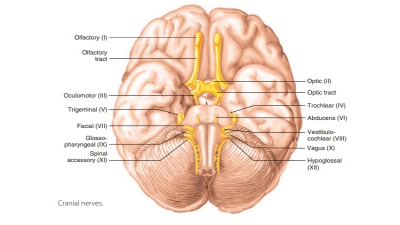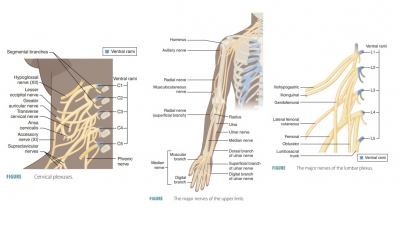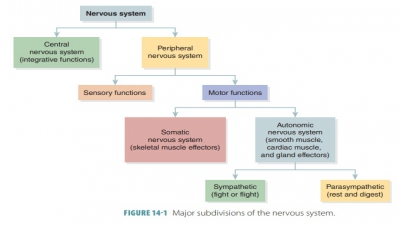Somatic Nervous System
| Home | | Anatomy and Physiology | | Anatomy and Physiology Health Education (APHE) |Chapter: Anatomy and Physiology for Health Professionals: Peripheral Nervous System and Reflex Activity
The SNS differs from the ANS in that it stimulates skeletal muscles, whereas the ANS innervates glands as well as cardiac and smooth muscle.
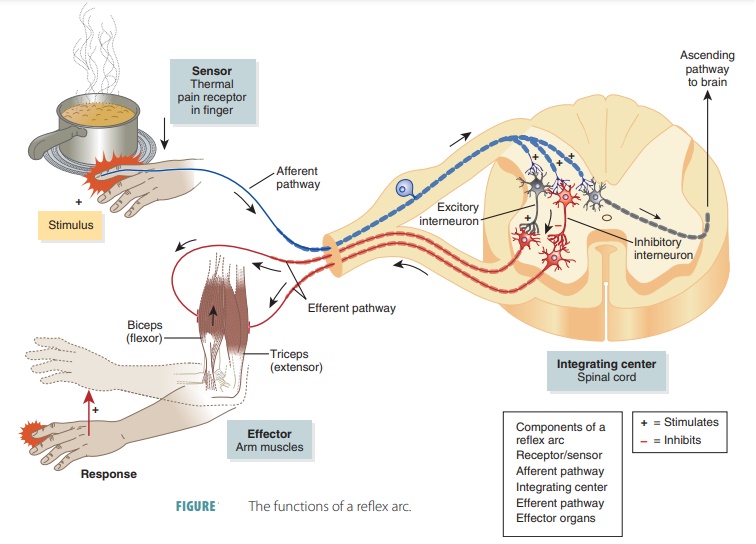
Somatic
Nervous System
The SNS differs from the ANS in
that it stimulates skeletal muscles, whereas the ANS innervates glands as well
as cardiac and smooth muscle. Other differences are based on the physiology of
the effector organs of each system. In the SNS, motor neuron cell bodies lie in
the CNS, with their axons extending in spinal or cranial nerves, to reach
target skeletal muscles. Somatic motor fibers are usually thick and heavy.
These myelinated group A fibers conduct nerve impulses very quickly. This
differs again from the ANS, which uses a two-neuron chain to reach its
effectors.
Every somatic motor neuron
releases ACh at its axon terminal with a skeletal muscle fiber. Effects are
always excitatory. Muscle fibers
contract if the stim-ulation reaches threshold. Both somatic and auto-nomic
motor activities are regulated and coordinated by higher brain centers. Also,
both somatic and auto-nomic fibers are contained in most spinal nerves and in
many cranial nerves. The body’s ability to adapt to most internal and external
changes involves both visceral organs and skeletal muscles. A hard-working
skeletal muscle requires additional glucose and oxy-gen, so autonomic control
mechanisms increase heart rate and dilate airways.
Reflex Activity and Spinal Reflexes
A reflex is actually defined as a fast, automatic response to a
specific stimulus. Reflex activity in the human body can be either inborn
(innate) or learned (acquired). Inborn reflexes are rapid and predictable motor
responses to stimuli that are formed between neurons during human development.
They are invol-untary and subconsciously maintain body posture, help to avoid
pain, and control visceral activities. For example, a response to pain is
triggered by an inborn spinal reflex that operates without assistance from the
brain. We may only be aware of the final outcome of one of these basic reflexes
and not the process of the reflex itself. Many visceral reflexes are regulated
by the brain stem and spinal cord.
A learned reflex develops over
time, because of repeated reactions to stimuli. It is more complex than an
inborn reflex. An example is how an older driver may access learned reflexes
because of his or her expe-rience in driving, whereas a younger driver may have
yet to learn them. However, most inborn reflexes can be altered by learning and
conscious effort. In a sit-uation involving pain, the pain signals are quickly
transmitted to the brain by the interneurons of the spinal cord. Withdrawing
from the source of the pain involves serial processing by the spinal cord,
whereas awareness of pain involves simultaneous parallel pro-cessing of the
sensory stimuli.
Reflex Arc
In a reflex
arc, sensory impulses from receptors
can reach their effectors without being processed by the brain (FIGURE 13-7). Some
reflex arcs use interneu-rons and others do not. The five basic components of
the reflex arc are a receptor, a sensory neuron, an integration center, a motor
neuron, and an effector. A receptor is the site of the stimulus action. The
sensory neuron transmits afferent impulses to the CNS. In a simple reflex arc,
the integration center may be only a single synapse, located between a sensory
neuron and a motor neuron, referred to as a monosynaptic reflex. The sensory neuron synapses directly on a motor neuron. In a more complex reflex arc, multi-ple synapses with
chains of interneurons are involved and are referred to as polysynaptic reflexes. They
have a longer delay between stimuli and responses than monosynaptic reflexes.
The integration center for such reflexes lies within the CNS. A motor neu-ron
conducts efferent impulses from the integration center to an effector organ,
and an effector is defined as a muscle fiber or gland cell that responds to
these impulses by contracting or secreting. The most com-plicated spinal
reflexes are called intersegmental reflex arcs, in which many segments work
together and produce coordinated
motor responses that are extremely variable.
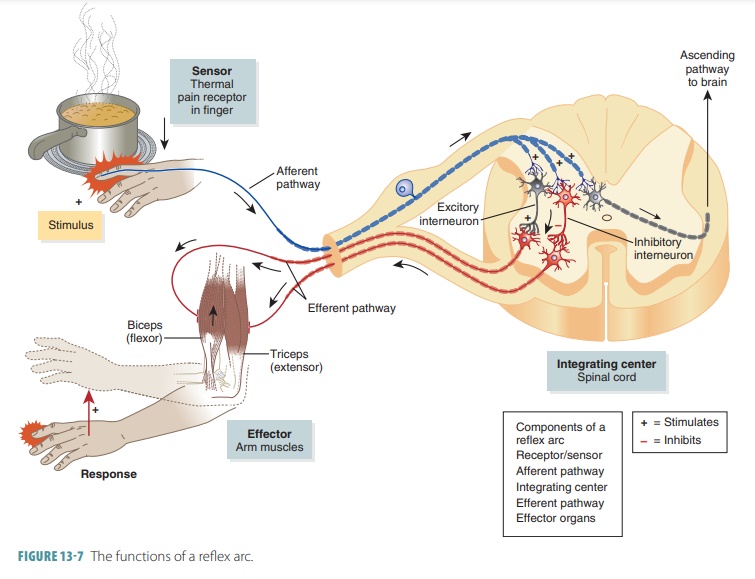
A somatic reflex is one that activates skeletal mus-cle, allowing for involuntary muscle control. Examples include superficial, stretch, and patellar reflexes. Sensory receptors used in stretch reflexes are muscle spindles that each consist of bundled intrafusal muscle fibers. The muscle spindle is surrounded by larger extrafusal muscle fibers. Somatic reflexes are also known as deep tendon or myotatic reflexes. An autonomic reflex is one that activates visceral effectors such as smooth or cardiac muscle or glands. An autonomic reflex is also known as a visceral reflex. In every visceral reflex arc, there is a receptor, a sensory neuron, and one or more interneurons. Visceral reflexes can be long or short. Long reflexes usually coordinate activities in an entire organ, with their actions processed by interneurons of the CNS. Short reflexes do not use the CNS at all but use the sensory neurons and interneurons with cell bodies in the autonomic ganglia. Short reflexes control simple motor responses with localized effects such as activities in a specific part of a target organ.
Spinal Reflexes
The spinal cord controls some
common somatic reflexes known as spinal
reflexes, which often occur without direct
involvement of the higher centers of the brain. These reflexes may still occur
when the brain is destroyed but the spinal cord is still intact and
functioning.
The brain is aware of most spinal
reflexes and can modify them in most circumstances. For normal spinal reflexes,
continual facilitating signals from the brain must occur. Spinal shock occurs when the spi-nal cord is transected, and as a
result, all functions controlled by the spinal cord are depressed. Somatic
reflexes provide important feedback when they are tested to assess nervous
system function. When they are absent, abnormal, or exaggerated, there may be
degeneration or pathology of certain regions of the nervous system. There may
be no other signs of dys-function present.
1. Identify
the five components of a reflex arc.
2. Differentiate
between somatic and autonomic reflexes.
3. Explain
how many spinal reflexes occur.
Related Topics

